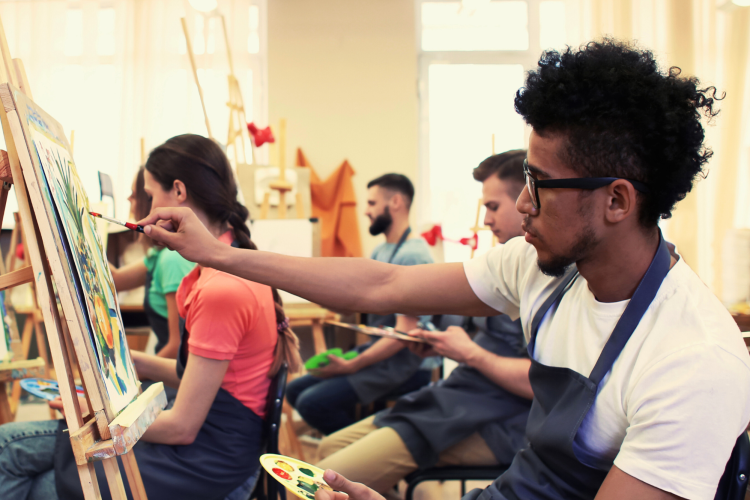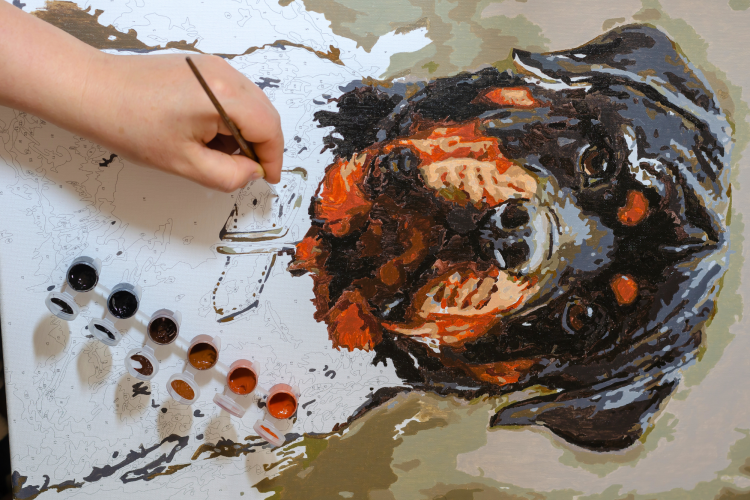Learn to Paint With These 11 Pro Tips for 2025

Are you looking for a fun and creative way to learn to paint? Painting, whatever the medium, style or subject matter, has long been an excellent way to express creativity and learn to see the world in a new way.
Long before photography and moving images, the greatest of painters were not only able to capture individual moments and moods but an entire universe on the canvas.
Their legacy can seem rather daunting to a beginner, but it's helpful to remember that every artist, however masterful, was also once a novice. How do I teach myself to paint? What should a beginner start painting? What is the most beginner-friendly paint? What are some beginner painting ideas?
We’ve rounded up a few key considerations and approaches to delving into this fun and relaxing art form to help you learn to paint with confidence.
Jump to Section
Learn to Paint Step by Step
1. Take an Art Class
One of the easiest and beginner-friendly approaches, when you want to learn to paint, is to take an art class. These courses are offered in a number of venues, including craft stores, supply shops, art centers, galleries and museums and academic institutions.
You can learn any number of mediums and techniques, from watercolor to oil painting under the direction of a practicing artist. Looking for art classes in Portland? Art classes in Houston? Art classes in NYC? You can find great art classes near you that will make diving into the art form easy.

2. Join a Paint and Sip
A slightly boozier and more social variation on a traditional art class, paint and sips have sprung up all over the country as a way to meld socialization and interactive artmaking. They are also a great entry point to learn to paint.
Led by talented and experienced artists, sessions offer a low-key way to kick back with cocktails and paint a shared subject with your friends and other participants. Each of you creates your own interpretation of the subject matter, which includes gorgeous landscapes, still lifes and portraits.
You can find paint and sip in Tampa, paint and sip in Sacramento and paint and sip in Milwaukee. In most regions, there is likely a great paint and sip near you. These events also make a great couple painting idea or paint party idea for adults. If you're wondering whether paint and sip is worth the money, we think the answer is a resounding yes. Here's how to host a paint and sip party to get started.

3. Choose Your Paint
If you are beginning on your own with a desire to learn to paint, you will want to experiment with a variety of materials and paint mediums, which includes not only the type of paint you are working with but also the paper, canvas or other surface that you are applying it to.
Acrylic paint is a great paint variety for beginners because it is water-based, inexpensive and easy to clean up. You can purchase the colors in individual tubes or jars or in varying-sized sets with multiple colors in smaller tubes.
Watercolor paint, the medium of choice for masters like the Impressionists Monet and Renoir, are another great water-based paint that is available both in tubes and in dried form in palettes (adding water will activate them.) Different intensities of color can be achieved by adding more or less water to each shade as desired. It’s a medium that is great for natural subjects since often you can create soft washes of color that are translucent.
Oil paint requires a bit more clean-up considerations as it is oil-based, but many artists swear they are the most forgivable of paints during use, remaining wet and malleable longer after application. They are also the choice of centuries of master painters for their durability, deep, vivid colors and amazing texture.

4. Choose Your Surface
Numerous painting surfaces work better or worse with varieties of paints. Watercolorists often prefer paper specifically designed for the medium, a variety of semi-absorbent, thick and textured white paper available in pads, rolls, and sketchbooks.
Oil painting, which is heavier, is usually best on a pre-treated and primed canvas, either framed out from wood or loose.
A great surface for the beginning artist is canvas boards, which offer the feel of traditional canvas, but are flat, easy to maneuver and inexpensive to buy in bulk.
Acrylics work equally well on paper or canvas, but can also be used well on other surfaces like wood and cardboard. You can discover the best paints for any kind of surface as you learn to paint, including the perfect paints for things like textiles, pottery and glass.

Learn to Paint Online
5. Enroll in Online Classes
If you are looking to learn to paint online in the comfort of your home, there are a number of excellent online painting classes available, most of which give you live or recorded guidance from a skilled painter.
You can find classes and resources devoted to every painting technique and style of painting, including Impressionism, abstract art or photorealism.
Virtual classes offer you a chance to learn painting online step by step. They are also available at escalating levels, which means if you enjoy a beginner session, you can easily go on to the next level. Options include watercolor painting for beginners, acrylic painting ideas for beginners and how to start oil painting.

6. Familiarize Yourself With Color Theory
You can't learn to paint without knowing the general basics of color theory. After all, MIT refers to color as a principal element of visual art. This is the key to getting the best results and achieving the colors you desire, like learning how to make red paint or how to make brown paint and other colors.
Once you get the hang of mixing colors, you are no longer limited to the shades in front of you, but an array of shades created by mixing paints.
This includes everything from simply adding white to create lighter shades of a color to mixing in colors on the opposite side of the color wheel to lessen the intensity of primary colors and create new ones. Even with only a small beginner-friendly set of paints, you can create a rainbow of available colors.

7. Watch a Video Tutorial
How can I learn to paint at home for free? Video tutorials are a great resource as you learn to paint, especially as a quick way to answer questions about materials, techniques and subject matter — perfect when you want to learn painting online step by step.
This includes everything from in-depth tutorials to brief how-tos on both artmaking and related questions, such as ways to market and sell art, how to clean paint brushes and setting up a great studio space.

8. Mimic the Masters
A tried and true way to get a grasp on how a favorite painting was created is to attempt to recreate it yourself. This was often the apprenticeship technique offered by great European painters in centuries past.
By attempting to achieve the same results as a finished work, you learn how those effects were created and can then apply them to your own work. Try finding high-quality images online or explore a number of museums and galleries that offer virtual tours of their collection worldwide.

Learn-to-Paint Kits
9. Paint-by-Numbers Kit
If you are strolling the aisle of your favorite art or craft store and have no idea where to begin, you can always try a paint-by-number kit as a fun way to learn to paint.
With a pre-chosen design and all the colors you need in one tiny box, they are a great way to get used to the feel of a brush in your hand and how to apply paint to a surface.
The numbers will help you understand differences in shading and how lighter/darker shades work together to create depth. Number painting sets are one of the most beginner-friendly learn-to-paint kits and make great gifts for kids and adults.

10. Ready-Made Paint Sets
Created specifically for students and beginning artists, these sets usually include an array of colors and painting surfaces, as well as brushes, cloth and other materials you may need, usually at a more affordable price than buying them individually — making them great gifts for artists.
Some also include a carrying case and easel set-up. You can find mess-free paint sets for kids or browse more sophisticated paint sets for adults.

11. Material-Specific Sets
For those who want to learn to paint different mediums and materials, you can also find paint kits that focus on unique forms, such as fabric painting sets, glass painting sets or wood painting sets.
Other great kits to try as you learn more include metallic paints, richly colored alcohol inks and other ways to apply color, such as with watercolor painting sets and oil painting sets.

As for what you paint, the sky's the limit. From landscapes and still lifes to pet portraits, the more you learn to paint, the more you will likely want to.
Whether you are looking to launch into an exciting creative career or just paint something pretty for your home, there are a number of easy and engaging ways to learn to paint. Now that you have all the basics down, turn them into profits by learning how to start a paint and sip business.
For even more fun painting ideas, check out other experiences happening on Classpop!

